The 2017 China Luxury Market Study by Bain & Company revealed important insights into the Chinese market that luxury brands should take note of.

The 2017 China Luxury Market Study by Bain & Company revealed important insights into the Chinese market that luxury brands should take note of.
After a sluggish few years for the luxury industry in China, reports have shown that the tides are finally starting to turn. In Bain & Company’s latest China Luxury Market Study, it was found that the country’s domestic market surpassed overseas purchases in 2017, and grew by 20%.
The signs are positive to say the least, but this is by no means an indication for brands to rest on their laurels. The report raised several other interesting insights into the changing face of the industry. Here are our five main takeaways:
Join Luxury Society to have more articles like this delivered directly to your inbox
1. Female Consumer Goods Are Main Drivers Of Growth

According to the study, the top three drivers of domestic market growth are cosmetics (including perfumes and personal care products), jewellery and women’s wear. These categories accounted for 28%, 27% and 24% of the total spend on luxury items in the market.
2. Targeting Millennials Is Key

It is no secret that luxury brands have been increasingly concerned with appealing to the millennial generation. And this report only affirms the importance of doing so. The average number of times millennials purchased luxury goods in 2017 was around eight, compared to the approximate five times clocked by the other generations. Nearly 93% of these millennials also claimed that they intended to purchase even more fashionable luxury items within the next three years.
Having grown up in the Internet era, this generation unsurprisingly relies heavily on digital channels to receive information about such brands. Those between the ages of 20 to 25 spend a purported 22 hours a week on average on digital platforms, while those between 26 and 34 years of age spend about 21 hours.
3. The Importance of Digital Channels

To reach this growing group of luxury consumers, brands are aggressively increasing their spending on digital marketing. As recently as 2015, brands were spending about 35% of their budgets on digital marketing, and the rest on traditional marketing. In 2017, this changed significantly with brands investing nearly 40 to 50% of their budgets on digital marketing.
In the years since, WeChat has also been identified as a key platform for investment and brands are spending between 30 to 60% of their digital marketing budgets on the mobile social media platform. Luxury brands are increasingly making use of this killer App as an all-encompassing means of reaching target audiences. More than just a social network, it has also become a means for brands to extend customer service to clients, manage loyalty programmes and carry out e-commerce activities.
4. Exclusivity and Authenticity Crucial To Chinese Consumers

Highly discerning, Chinese consumers are greatly concerned when it comes to the authenticity of the products they purchase. This is a valid concern, given the sheer number of counterfeit luxury items floating on the online marketplace.
While brands have been taking a firm stance against this, it is difficult to completely eradicate the existence of such items. As such, 70% of Chinese consumers surveyed noted that they prefer to shop on the official websites of brands, even if it means higher price points compared to luxury aggregators – simply because authenticity can be guaranteed.
Apart from that, respondents also noted that they favoured official brand websites for the exclusive shopping experience.
5. China Is The Future Of Luxury

With Chinese luxury spending accounting for a total of 32% of the global luxury market in 2017, it is clear that winning in this market is key for brands. This segment is only set to grow in the coming years, with the price harmonisation measures taken by brands worldwide, as well as renewed consumer confidence.
With around 30% of the Chinese population now comprising of millennials, it is clear exactly whom brands should be targeting in the coming years.
All image credits: Bain & Company










